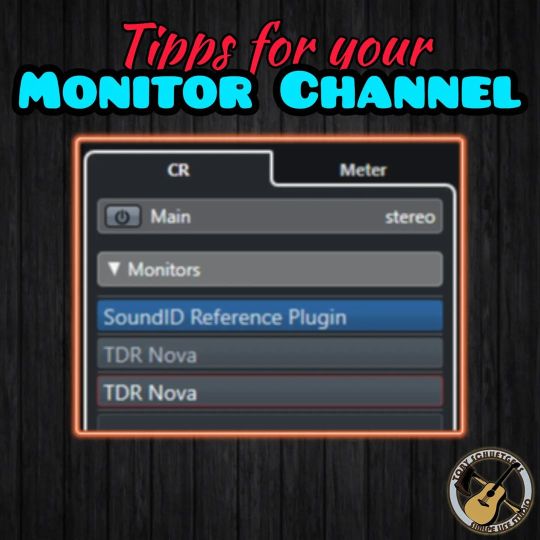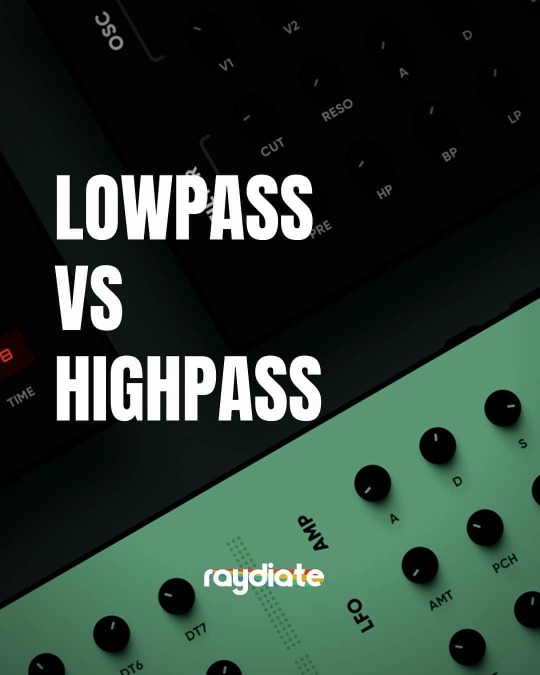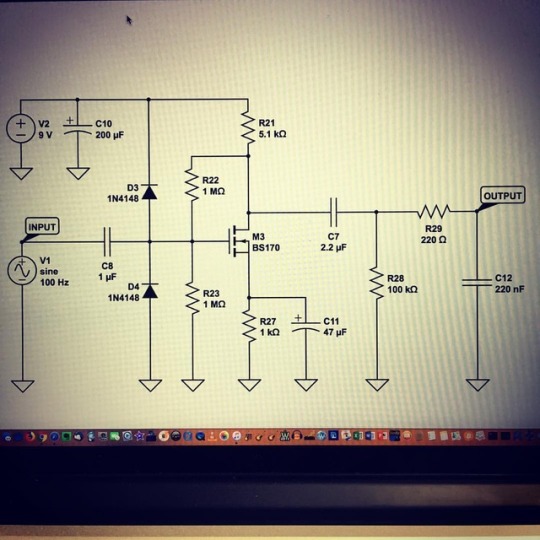#Lowpassfilter
Explore tagged Tumblr posts
Text
youtube
Riot VCF Low Pass Filter for Eurorack Modular Synthesisers
0 notes
Text
youtube
#CapacitorAsFilter#ElectronicFilters#FrequencyFiltering#CapacitorWorking#CapacitorExplainedHindi#Filters#SignalFiltering#LowPassFilter#HighPassFilter#BandPassFilter#BandStopFilter#PowerSupply#NoiseReduction#SignalProcessingBasics#ElectronicsInHindi#HindiTutorial#TechHindi#LearnInHindi#IndiaTech#HindiEducation#एलेक्ट्रॉनिक्स#तकनीक#ElectronicsHindi#BasicElectronics#CircuitDesign#SignalProcessing#TechInHindi#LearnElectronics#Electronics#ScienceInHindi
0 notes
Text
youtube
Let's make a little bit of a left turn today, shall we? Using a KORG US SQ-1 Step Sequencer, we're gonna explore the marvelous Vongon Paragraphs Resonant Low Pass Filter - this one gets WEIRD, so buckle up and check out our demo over on YouTube!! Happy Saturday!!
#pedaloftheday#vongon#paragraphs#lowpassfilter#filter#filters#filterpedal#EffectsPedals#pedalsandeffects#effects#pedals#pedalboard#Youtube
0 notes
Photo

Do you have a dedicated monitoring channel? Here is an easy workflow tipp for switching between different monitoring modes: The first plug-in in my monitoring channel is sonarworks soundID as corrective room / headphone EQ. With this plug-in I can switch between the original sound of my room / headphones and an almost flat response. The second plug-in is a mid-range filter EQ I usually set up with a high pass (low cut) filter at about 400hz and a low pass (high cut) filter at about 8khz. This simulates small speakers like that old kitchen radio for example. I do spend a lot of time mixing with this filter turned on. The third plug-in is just a low-end filter EQ. It's just a low pass (high cut) filter at about 150hz. This helps a lot to check low-end stuff like comparing to references for example. By the way: what's also very helpful on the monitoring channel is a mono button. This settings for a monitoring channel are saved in my mixing and mastering templates. I need to switch back and forth real quick without setting up the filters when I need them. This would take too much time and effort and breaks the creative flow during the mixing sessions. Do you have another helpful tipps for monitoring and quick workflows? Feel free to drop comments 😉 #monitoringchannel #musicproduction #audioproduction #mixing #mastering #roomEQ #headphoneEQ #sonarworks #EQfilter #highpassfilter #lowpassfilter #midrangefilter #smallspeakers #mixingworkflow #masteringworkflow #monobutton #audioengineering #homestudio #mixingtips #masteringtips https://www.instagram.com/p/Cp3X71AMtXe/?igshid=NGJjMDIxMWI=
#monitoringchannel#musicproduction#audioproduction#mixing#mastering#roomeq#headphoneeq#sonarworks#eqfilter#highpassfilter#lowpassfilter#midrangefilter#smallspeakers#mixingworkflow#masteringworkflow#monobutton#audioengineering#homestudio#mixingtips#masteringtips
0 notes
Text
Basic Electronics Components
Electronic components are fundamental discrete gadgets in any electronic framework to use in electronics in any case extraordinary related fields. These components are fundamental components that are utilized to plan electrical and electronic circuits. These components have at least two terminals which are utilized to interface with the circuit. The arrangement of electronic components should be possible dependent on applications like dynamic, aloof, and electromechanical.
In planning an electronic circuit following are mulled over:
Fundamental electronic components: capacitors, resistors, diodes, semiconductors, and so on.
Power sources: Signal generators and DC power supplies.
Estimation and examination instruments: Cathode Ray Oscilloscope (CRO), multimeters, and so forth.
Classification of Electronic Components:
Electronic gadgets are part of our daily life. If you are as old as me, you might remember when you used to wait to use the phone booth to contact your friend after writing them a letter and stating when you could have a chat. Nowadays, you can hardly function if you forgot your phone rushing to catch that train as we are always tethered to them 24 hours 7days a week.
Anyway, back to electronic components. They are classified into two groups namely:
1. Active components: Active components supply current or energy in an electronic circuit and examples of these can be generators, alternators, diodes, transistor, voltage, MOSFET, Logic gates, and current sources.
What are active components?
Other examples of active components like amplifiers, vacuum tubes, and transistors will help us understand these basic electronic components. Active components tend to use external sources of power to add energy or power the circuit or system. In more simplistic terms, they control how electricity flows in a circuit.
Types of active components:
• Integrated Circuits (All)
• Processor
• Power ICs
• Digital Circuit
• Analog Circuit
• Ball Grid Arrays
• Optoelectronic Components
• Hall Effect Sensor
• Current Sensor
• LED / VFD / CRT / LCD / TFT
• Rectifier Tubes
• Vacuum Tubes
• Battery & Power Supply
• Electric Generator
• Emitters
• Gas discharge tube
• Ignitron
• Thyratron.
2. Passive components: These types of components receive the energy which it can store, dissipate in either a magnetic field or an electric field. You must have heard of resistors, inductors, transformers, and capacitors which are the most common examples of passive components.
What are passive components?
As their name suggests they do not require energy like power to operate and ,therefore, do not provide gain and amplification to a circuit but rather attenuate.
Types of passive components:
• Field-Effect Transistor (FET)
• JFET (Junction Field-Effect Transistor)
• MOSFET (Metal Oxide Semiconductor FET)
• Diodes (All)
• Rectifier Diode
• Schottky Diode
• Zener Diode
• Unipolar / Bipolar Diode
• Varicap
• Varactor
• Light-Emitting Diode (LED)
• Transistors (All)
• Photo Transistor
• Darlington Transistor
• Compound Transistor
• Thyristors
• Composit Transistors
• Solar PV Cell, PV Panel
• T flip flop & Logic circuit
#Electronicparts#Electroniccomponents#SemiconductorICs#DCDCconverter#Voltageregulators#Microcontrollers#Sensors#Fpga#Powersupplies#Connectors#ACDCconverter#Tflipflop#Printedcircuitboards#electroniccomponentssuppliers#Raspberrypi4#Singleboardcomputer#Lowpassfilter#Ceramiccapacitor
1 note
·
View note
Photo

Audio filters are simple yet powerful tools for shaping sound that have been in use for a long time, but are still very important to modern production. Filters have the ability to completely transform the tone of any audio and are most often used to remove or enchance frequencies. There are many different audio filter types that serve different purposes. With each different filter type, you will find common controls that function in more or less the same way across all types. In this article, we’ll look at 2 most common types of filters used (LPF & HPF) and break them down easily so you know exactly what they do. Hope this helps 🙂. Follow ➡️ @raydiate.in . . . . . #dj #djproducer #musicproducer #musicproductiontips #ableton #musicproduction #audiofilter #lowpassfilter #highpassfilter #lpf #hpf #ableton #flgang #flstudio #producermemes #frequencies #audio #sounddesign #soundengineer #mixingandmastering #edm #edmproducer #analogsynth #techno #typebeat #electronicmusic #beatmaker #artistsoninstagram #musician #guitarists #audioeffects https://www.instagram.com/p/CQ74A-qr5ED/?utm_medium=tumblr
#dj#djproducer#musicproducer#musicproductiontips#ableton#musicproduction#audiofilter#lowpassfilter#highpassfilter#lpf#hpf#flgang#flstudio#producermemes#frequencies#audio#sounddesign#soundengineer#mixingandmastering#edm#edmproducer#analogsynth#techno#typebeat#electronicmusic#beatmaker#artistsoninstagram#musician#guitarists#audioeffects
0 notes
Photo

x2 🖇 , x2 4.7KΩ resistors, and a 4.7uF capacitor. Low pass filter at 10Hz via Elenco Training Kit and Rigol 4 channel oscilloscope. #electronics #circuitdesign #engineering #lowpassfilter https://www.instagram.com/p/CM9xL-KMNlf/?igshid=1qvi0uak422i5
0 notes
Photo

Voltage Controlled Filter Can't believe I actually made an analog modular synthesizer from scratch. It's not finished - never will be - but it's now a fully usable, pretty grown modular system. Looking forward to share the sound with you on our next album! #modularsynthesizer #lpf #lowpassfilter #fourpole #modularsynth #modularsynths #sdiy #diysynthesizer #diyelectronics #diyfilter #modulardreams #rockprogressivo #moogsystem55 #moog #modular #hoursofsoldering #progrock #knobs #vintagesynth https://www.instagram.com/p/BzbSd3_oxSX/?igshid=3k6w5ueeqpsc
#modularsynthesizer#lpf#lowpassfilter#fourpole#modularsynth#modularsynths#sdiy#diysynthesizer#diyelectronics#diyfilter#modulardreams#rockprogressivo#moogsystem55#moog#modular#hoursofsoldering#progrock#knobs#vintagesynth
0 notes
Photo

#wegoagain #gris #lowpassfilter #negroyblanco #paulcabada #oneshot #eos #rebel #godox #fotodiox #canon #grayphotography #bnwphotography #green #flower (en Panama, Panama) https://www.instagram.com/p/BtmTk9gHfWA/?utm_source=ig_tumblr_share&igshid=2yyb4h4uoq0t
#wegoagain#gris#lowpassfilter#negroyblanco#paulcabada#oneshot#eos#rebel#godox#fotodiox#canon#grayphotography#bnwphotography#green#flower
0 notes
Text
youtube
904C Filter Coupler for System 55
#synth#synthesizer#904c#system55#behringer#fitzgreyve#filter#modular#eurorack#lpf#lowpassfilter#ozhall#Youtube
1 note
·
View note
Link
Passive Low Pass Filter & Its Types With Example
0 notes
Photo

NEW REVIEW & DEMO: @drscientistsounds Dusk Multi Mode Low Pass Filter WE GOTTA HAVE THE FUNK!! Check out our YouTube demo and review on our website to get all the info on this one. Ciao! #pedaloftheday #guitarpedals #guitareffects #effectspedals #pedalsandeffects #gearnerds #gearpassion #becausetone #knowyourtone #tonefordays #toneheaven #gearshots #gearphoria #notpedalbored #drscientist #dusk #funk #filter #lowpassfilter #envelopefilter #cowfunk #cowphunk https://www.instagram.com/p/CIqiNhClMS7/?igshid=ebqsfnosqfc7
#pedaloftheday#guitarpedals#guitareffects#effectspedals#pedalsandeffects#gearnerds#gearpassion#becausetone#knowyourtone#tonefordays#toneheaven#gearshots#gearphoria#notpedalbored#drscientist#dusk#funk#filter#lowpassfilter#envelopefilter#cowfunk#cowphunk
3 notes
·
View notes
Photo

#StompBox #MOSFET #preamp #LowPassFilter
0 notes
Video
instagram
#chicagohouse #bouncybass #studio #mpc2000xl #chopchop #korgpoly800 #bouncybasslines #lowpassfilter #resonance #hihat #loggetto #housemusic #dance #clap #discuteca
#dance#housemusic#clap#studio#discuteca#loggetto#korgpoly800#mpc2000xl#bouncybass#lowpassfilter#chopchop#resonance#hihat#chicagohouse#bouncybasslines
0 notes
Text

Mein heutiges Thema: Der Equalizer
Er ist das Grundinstrumemt eines jeden Musikproduzenten wie Toningeniur - ob analog oder eben - wie in meinem Fall - digital. Auf dem Bild zu sehen ist der EQ8 des Sequenzers / der Produktionssoftware "Ableton Live". Im virtuellen dreidimensionalen "musikalischen Raum" des Mixdowns ist er für die vertikale Determinante, die Bearbeitung des Frequenzbereichs, zuständig. Zur grundsätzlichen, virtuellen Vorstellung: Tiefe Audiofrequenzen klingen, als ob sie "am Boden entlang kriechen", während höhere Frequenzen über den Hörer hinwegzufliegen scheinen. Mittige Frequenzen hingegen wirken sehr dominant. Der Hörer begegnet ihnen sozusagen "auf Augenhöhe".
Bearbeitbar ist der für den Menschen hörbare Bereich elektromagnetischer Schwingungen (Frequenzen) zwischen 28 Hz und 20 kHz (20.000Hz). Beim hier sichtbaren EQ8 können dabei maximal 8 Frequenzen bearbeitet bzw Fixpunkte gesetzt werden. So können Frequenzbereiche erhöht, abgesenkt oder über Hochpass- und Lowpassfilter als obere / untere Grenze des Frequenzbereichs der jeweiligen Audiosequenz festgelegt werden. Die sogenannte Filtergüte Q regelt dabei, wie groß der zu bearbeitende Bereich des jeweils gewählten Fixpunkts sein soll. Auch ist es möglich, innerhalb des genutzten Frequenzbereichs einzelne Frequenzbereiche aus dem Sound zu eliminieren.
Generelle Ziele, die es mit dem Equalizer zu erreichen gilt:
1. Sich schneidende Frequenzen verschiedener Elemente minimieren, den genutzten Frequenzbereich möglichst minimal halten
2. Den Ton selbst optimieren. Bsp: Eine Absenkung des Bereichs um die 7000Hz lässt den Sound "warm" wirken.
3. Eine Charakterisierung und Priorisierung des betreffenden Elements erreichen
Mein Spezial-Tipp: den Equalizer zuletzt, nach der sonstigen Bearbeitung nutzen. Die Reihenfolge der Bearbeitungstools ist relevant. Andernfalls ändern diese die Frequenzen im Anschluss doch noch und der Equalizer stellt nicht die finale Bearbeitung dar.
Nächster Beitrag: Anwendungsbeispiel EQ8
1 note
·
View note